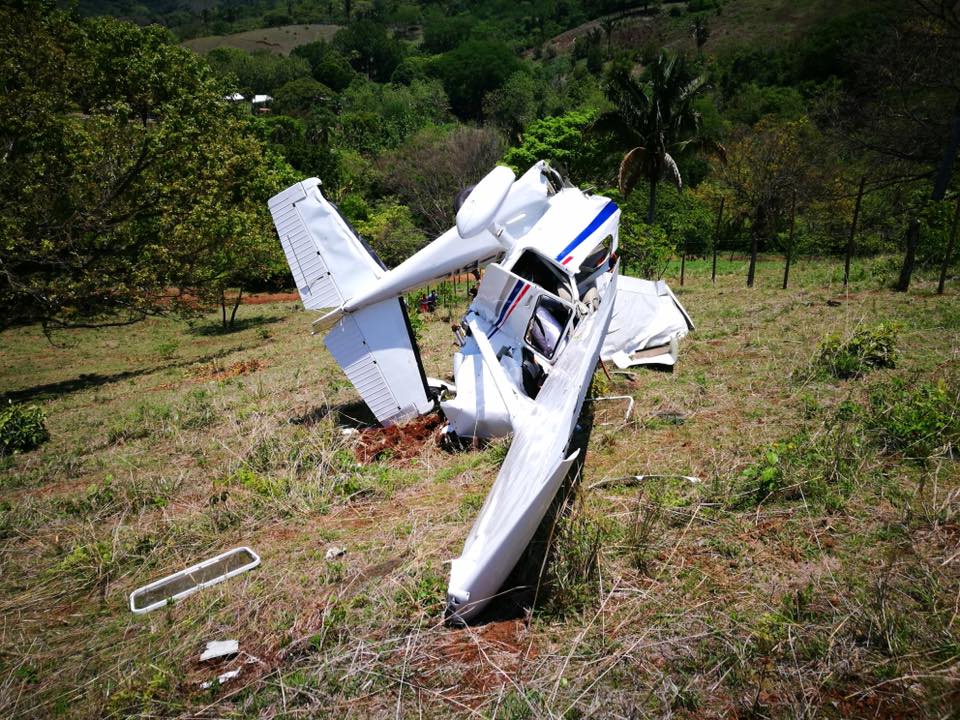
ASN Wikibase Occurrence # 210057
This information is added by users of ASN. Neither ASN nor the Flight Safety Foundation are responsible for the completeness or correctness of this information.
If you feel this information is incomplete or incorrect, you can submit corrected information.
| Date: | Saturday 28 April 2018 |
| Time: | c. 11:45 |
| Type: |  Cessna 172S Skyhawk SP II |
| Owner/operator: | Aerobell Flight School |
| Registration: | TI-BIL |
| MSN: | 172S9121 |
| Year of manufacture: | 2002 |
| Fatalities: | Fatalities: 2 / Occupants: 2 |
| Aircraft damage: | Destroyed |
| Category: | Accident |
| Location: | Corozalito de Nandayure, Guanacaste -
 Costa Rica Costa Rica
|
| Phase: | En route |
| Nature: | Training |
| Departure airport: | Punta Islita Airport (PBP/MRIA) |
| San José-Tobias Bolanos International Airport (SYQ/MRPV) | |
| Confidence Rating: |
The plane crashed under unknown circumstances. One occupant died in the crash, another died minutes later.
The aircraft, TI-BIL, was added to the fleet of Aerobell Flight School on March 17, 2018.
Probable Cause
During a dual command training flight while practicing landings and takeoffs, after the second takeoff, after 40 seconds of flight the aircraft hit the top of a tree with its left wing, which caused the loss of control and subsequent impact against the ground. The impact of the aircraft's wing tip with the tree was due to:
An improper configuration of the flaps during the second takeoff, which adversely affected the aircraft's climb performance, making it impossible to overtake the obstacle in its flight path.
Contributing factors.
- The approach for the second landing was unstabilized which caused the aircraft to overshoot more than half of the runway and, after making contact, performed a series of bounces.
- The second takeoff was performed with a flap configuration greater than 20°, in discrepancy to what is established in the aircraft's flight manual.
- The previous fact, although it allowed the aircraft to reach the lift off speed and take off from the ground and to rise approximately 20 meters, had a considerable influence on the decrease of the climb performance.
There was no prior knowledge between the student and the instructor in their manner of flying and pedagogy, because it was the first flight between the two. In addition, both were probably unaccustomed to both instructor pilot and student pilot duties.
- Absence of a route manual and procedures for route training selection.
- Absence of a procedure for retraining flights for both instructor pilots and student pilots for when they are out of activity in these areas for an extended period of time.
- Tailwind from heading 03 propelled the aircraft along the runway. The runway was extended and, at the same time, the tendency of wind shear on the leeward side of the mountains abutting head 21 affected the attainment of the airspeed necessary to keep the aircraft in flight.
Narrativa en español:
La aeronave se inició plan de vuelo desde las 10:35 a. m. cuando salieron del aeropuerto Tobías Bolaños (MRPV), en Pavas, con destino a Punta Islita, adonde llegaron a las 11:10 a.m, despues de varios toques y despegues (con algunas aproximaciones fallidas segun testigos), toman regreso al Tobias Bolaños minutos antes del accidente, en el momento del despegue, la aeronave no consigue suficiente altitud, está misma se dirige a un potrero ubicado a unos 570mts de la cabecera 21 de la pista de Punta Islita, el cual está ubicado hacia la derecha del rumbo de pista, posiblemente fue el lugar mas adecuado, segun la desicion del piloto al mando, para realizar esta maniobra de emergencia.
El potrero, al ser en pendiente, hace dificil que la aeronave pudiese aterrizar de manera segura, consiguendo que esta impacte el morro haciendo que se vuelque hacia adelante, fracturando la seccion de cola del avion y comprimiendo la cabina.
En el lugar, tras el accidente, el instructor de vuelo pierde su vida minitos despues al llegar algunos pobladores de Corozalito en su socorro, el estudiante es extraido con vida, pero pierde su vida un par de horas despues en el hopital de Nicoya producto de sus heridas.
Las razones del accidente y del porqué el avion no consigue elevarse lo suficiente, aun son inciertas, pudo producirse por alguna falla mecanica o no, pero es notable que el avion es encontrado con los flaps completamente retraidos, lo cual resta sustentacion.
la aeronave cae a unos 600mts al sureste de donde cayó en Caravan TI-BEI un par de meses atrás donde perdieron la vida 12 personas.
Accident investigation:
 |
|
Sources:
https://www.teletica.com/192611_accidente-de-avioneta-en-guanacaste-deja-un-muerto-y-un-herido-delicado
https://www.facebook.com/AerobellFlightSchoolCR/photos/a.341661116038843.1073741829.341656622705959/757487557789528/?type=3&theater
Images:

Media:
🛩️🇨🇷Plane crashes in Guanacaste this Saturday morning, left one person dead and one in serious condition. Crash occurred 200 meters away from Corozalito Square, in the canton of Nandayure, Costa Rica.
— Planes Of Legend (@PlanesOfLegend) 28 avril 2018
El suceso ocurrió la mañana de este sábado https://t.co/WXTPyW73fo pic.twitter.com/4WISlvuGEb
Revision history:
| Date/time | Contributor | Updates |
|---|---|---|
| 28-Apr-2018 19:03 | gerard57 | Added |
| 28-Apr-2018 19:23 | harro | Updated [Time, Aircraft type, Nature, Departure airport, Destination airport, Embed code] |
| 28-Apr-2018 19:27 | harro | Updated [Aircraft type, Cn, Operator, Source, Narrative] |
| 28-Apr-2018 21:37 | Iceman 29 | Updated [Source, Embed code, Narrative] |
| 29-Apr-2018 07:01 | Iron_Hell | Updated [Total fatalities, Location, Embed code, Narrative, Photo, ] |
| 06-Jun-2018 05:54 | Iron_Hell | Updated [Departure airport, Destination airport, Narrative] |
Corrections or additions? ... Edit this accident description
The Aviation Safety Network is an exclusive service provided by:


 ©2024 Flight Safety Foundation
©2024 Flight Safety Foundation